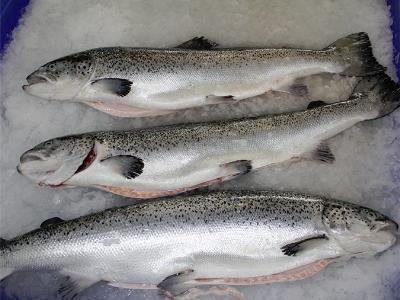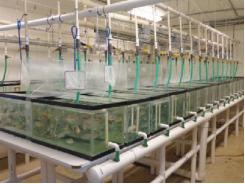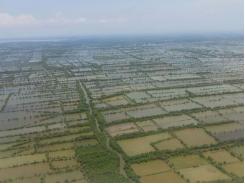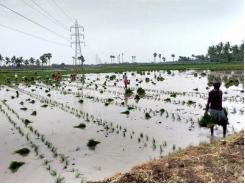Aquaculture viruses: An Atlantic salmon case study

Recounting a catastrophic outbreak of IHN virus in British Columbia
The Atlantic salmon is a very important aquacultured fish produced in several areas around the world, from western Canada to Tasmania. Photo by Darryl Jory.
Viruses are often the most potentially damaging pathogens in nature, and their capacity to cause destruction in wild stocks as well as in aquaculture facilities is well documented. In a visit to the Epping Campus of Melbourne Polytechnic a few years ago, one of us (Paul Hardy-Smith) presented a guest lecture on case studies of viruses in aquaculture, which featured considerable personal investigative involvement. One of these was an outbreak of Infectious Haematopoietic Necrosis (IHN) virus in British Columbia, Canada, which will be reviewed in this article.
The IHN virus in Canada
One of the nastiest outbreaks of a virus that Hardy-Smith was ever involved with was the explosion of Infectious Haematopoietic Necrosis (IHN) virus at a sea cage site in northern Vancouver Island, British Columbia, Canada, several years ago. At the time, the enterprise had around 1.6 million Atlantic salmon (Salmo salar) juveniles in sea cages, with a total biomass of approximately 250 tons and with most fish in the 50- to 250-gram size class.
The fish were often kept in “100 bys,” so named because they are 100-square-foot (33-square-meter) cages. The fish were moved from hatcheries in the south of Vancouver Island to the sea cage sites in well-boats, and the enterprise had a remarkably clean bill of health, with no viral history. Life was good … and then things started going wrong.
Spikes in the numbers of mortalities (well beyond what would normally be expected) started to occur, and co-author Hardy-Smith, at the time the veterinarian for the company affected, flew in by seaplane to this remote location to investigate the problem.
Initially, the first visible signs of disease in the fish were mouth plaques (commonly called mouth rot), which are thought to be caused by bacterial infections resulting from disturbances to gut microflora. One commercial antibiotic was found to be quite effective, and although Hardy-Smith is generally reluctant to prescribe antibiotics in many situations (rightly believing that there are underlying root causes of disease, such as stress brought on by degraded water quality or poor husbandry practices that should be addressed first), without such antibiotic treatment the mortality rates were found to be in the order of 75 percent of a given sample of fish for this particular disease if left untreated!
At that point, there did not appear to be anything obvious or sinister happening internally with the fish. While initial treatments appeared to work adequately, massive spikes in mortality were again observed only three days after treatment.
So, what was causing such huge numbers of mortalities? Fish autopsied revealed a confusing picture; dark stains in the gut cavity, which could easily be mistaken for hemorrhaging to the untrained eye, were readily visible (Fig. 1). Hardy-Smith could establish that the dark staining was actually melanization, essentially the production of pigment due to exposure to a vaccine that had been given to these fish at the hatchery (vaccines for bacterial disease agents were routinely give to these fish). Maybe the cold temperatures (at that time between 8 and 10 degrees-C), together with the inflammation caused by the vaccine, were actually combining to kill the fish? Or could the cold temperatures be contributing to some type of toxicant production that was turning a remedy into a problem?

Fig. 1: A false indication; melanization can masquerade as haemorrhaging in fish; it appears here as faint flecks of black on the white visceral tissue of the fish. Photo by Dr. Paul Hardy-Smith.
Further investigation involved closer examination of some of the moribund (dying) fish, which were seen to be listless and extremely lethargic in the water. The fact that the three sea cages suffering the highest mortalities had recently been stocked with fish from a hatchery located in southern Vancouver Island (and could therefore be considered the most recent arrivals at the farm) was highly significant, as was the fact that the level of mortalities appeared to be increasing through all the sea cages. This made it extremely unlikely that the issue was caused by a toxicant, because sick fish would have been observed right across the farm, rather than having the disease issues concentrated in one corner of the farm and radiating out.
The haematopoietic (blood-producing) tissues at the anterior portion of the kidney, in particular, showed huge amounts of haemorrhaging in many fish (Figs. 2 and 3), remembering that moribund (dying) fish are the best ones to examine when in the middle of a disease epidemic. When subjected to laboratory analysis, samples of tissue, including the kidney and liver, were found to contain massive amounts of IHN virus. Finally, the smoking gun had been found and the disease-causing agent had been identified.

Fig. 2: An Atlantic salmon showing severe haemorrhaging around the anterior portion of the kidney, with accumulation of fluid in the peritoneal cavity. Photo by Dr. Paul Hardy-Smith, Panaquatic Health Solutions.
The actual strain of IHN virus was extremely virulent, and during laboratory trials, it was found to be so virulent that “it blew cell lines apart in a few days!” The IHN virus is considered endemic to Pacific salmon (of the genus Oncorhynchus, which include various salmon and trout species) in the region and, as a result, this species can carry the virus but may also have some conferred immunity, but Atlantic salmon has been found to be extremely susceptible.
The aquaculture enterprise found itself in the middle of a perfect biological storm – a virus that was extremely virulent to the species being cultured, and high numbers of young susceptible fish on the site that were to be moved to various locations, enabling the virus to spread very quickly from one sea cage to another.
Where a disease breaks out in a sea cage environment, it is imperative that cages are not moved, since this only spreads the virus further. In one instance during the epidemic, a cage from a neighboring farm was being moved and passed within 1 km of the infected site. Shortly thereafter, this cage of fish, along with the site it ended up at, became infected.

Fig. 3: Two examples of Atlantic salmon with the belly wall cut away, revealing extensive haemorrhaging into the muscle tissue. Photo by Dr. Paul Hardy-Smith.
Quick decisions needed
With so many infected fish, quick decisions were needed regarding the best course of action. One option was to try and weather the storm to see if some fish could come through the process and continue to be productive animals that could somehow be on grown. But there were no treatment measures available and the enterprise was stuck with the situation. Also, it was decided relatively early that the enterprise would be very open and not try to conceal the epizootic, quickly getting their key points and messages across to a concerned public.
While investigations were continuing and a strategy for dealing with the situation was being considered, the virus continued spreading rapidly throughout the farm. At the height of the epidemic an estimated 80,000 to 90,000 fish were being lost on a daily basis, and it was time for decisive action.
The economics of infection
The incubation period of the IHN virus can be as little as a few days, so that most of the fish on the site could be considered to have been exposed to infection, and likely infected. With the lack of a suitable treatment option, and many downsides to “weathering the storm,” there was only one option for control of the epidemic; killing off all the fish on the farm. This tough decision was not taken lightly, as the economic blow to the enterprise would be devastating, and of course the damage to staff morale from losing so many fish that they have reared is always a consideration, though not one that could have altered the suggested course of action.
IHN is not pathogenic to humans, and fish that were only in the early stages of infection and still looked reasonably healthy could, in theory, be safely consumed. With most of the affected fish in the 50 to 250-gram size class, however, the fish were far too small to harvest, so this was not deemed a viable option.
The broodstock site, which was approximately 5 kilometers away and part of a land-based hatchery system, was treated as the top priority and fortunately was found to be uninfected. These were the fish that the farm would rely on to repopulate it in the event that stocks were wiped out. The importance of these fish had now become even more critical, and it was imperative that any fish, biological products, equipment or even personnel from the infected site be forbidden from entering the broodstock facility to extinguish the merest possibility that the virus might jump to those precious fish.
Three commercial fishing boats with vast holds in their hulls were to transfer all 250 tons of fish from the cages to a rendering plant (Fig. 4). Fish pumps were used to physically take the fish out of the cages, and because many of the cages featured lethargic, infected fish, it was a relatively simple task. All fish were gone from the 25 sea cages of the farm within 48 hours and the operation became very efficient – ultimately taking only eight and a half minutes to pump the fish from a cage into the holds of the boats.

Fig. 4: A container full of dead fish on their way to the rendering plant. Photo courtesy of Dr. Paul Hardy-Smith, courtesy of Panaquatic Health Solutions.
With the boats already on their way to the rendering plants, an unwelcome complication arose. An official court injunction had been issued to the company that day, preventing them from off-loading any dead stock to the rendering facility located in the Fraser River, near Vancouver. Unfortunately, the issuing judge was aware (not informed?) of the fact that IHN is actually endemic to the Fraser River, where it has been known as “sockeye disease” (after sockeye salmon, Oncorhynchus nerka) for years.
Once the facts were made available to the authorities, the decision was reversed and the operation proceeded as planned. When all the fish had been pumped out of the boats onto land, the holds of the fishing boats were disinfected with chlorine used to kill off any remaining viral particles. The entire episode had occurred at a stunning and dizzying speed; the presence of the virus was confirmed on a Monday and by Thursday of the same week, the entire farm had been emptied.
Outbreak origin
So, how did this outbreak of IHN suddenly arise and infect this salmon facility? Was it just a random meeting of wild fish stocks and their aquaculture counterparts, with unhappy consequences? Was it something the enterprise did, or was it a translocation issue where fish stocks had somehow come into contact with fish or viral loads from another enterprise?
About two months after the outbreak, a stunning admission from an employee identified how it likely occurred. While in transit from the hatchery in the south to the northern sea cage site, a well boat with thousands of captive fish onboard suddenly encountered a vast pool of dark, bloodied water and travelled straight through it. It appears that a fish farming enterprise located en route had also suffered an outbreak of IHN but had not informed other companies. This company was discharging harvest blood water through which the boat carrying the young fish passed, and this water likely contained a heavy viral load. It was this water that was pumped onboard the well boat.
Once this had happened, the virus infected that particular shipment of Atlantic salmon, and when those fish were transferred to the main sea cage facility, the virus found a target-rich environment. The catastrophic death of all fish on the farm was the end result. While other enterprises had experienced IHN virus in the past, this particular enterprise had not and had managed to dodge it until that fateful day.
Perspectives
Co-author Hardy-Smith will always remember this period as being an incredibly hectic time of his life.
“It was one of those times where you come out the other side and know that you have been through something huge. Looking back, it was a very trying experience that thankfully does not come up that often in terms of the sheer size and scale of the problem that we were experiencing. This was just one of those real-life experiences that we were thrown into,” he said. “Thankfully, the aquaculture enterprise affected is still going strong today and producing considerable tons of salmon annually. Because they were such a large producer of Atlantic salmon, they could absorb the losses, as painful as they were; there is no doubt that a smaller producer would have been taken out of business by such an event.”
While a viral vaccine for IHN was not available back then, it is today, partly as a result of this particular viral outbreak, and aquaculture stocks are vaccinated against this serious threat as a standard part of husbandry.
Andrew Christie
Lecturer, Melbourne Polytechnic, School of Food, Plant and Animal Industries (Aquaculture Program), Cnr Cooper St and Dalton Rd, Epping, VIC 3076 Australia
Dr. Paul Hardy-Smith
Managing Director, Panaquatic Health Solutions Pty. Ltd., 3/814 Glenferrie Road, Hawthorn, VIC 3122 Australia
Có thể bạn quan tâm
Phần mềm

Phối trộn thức ăn chăn nuôi

Pha dung dịch thủy canh

Định mức cho tôm ăn

Phối trộn phân bón NPK

Xác định tỷ lệ tôm sống

Chuyển đổi đơn vị phân bón

Xác định công suất sục khí

Chuyển đổi đơn vị tôm

Tính diện tích nhà kính

Tính thể tích ao hồ




 Studying the stubborn salmon disease SRS from afar
Studying the stubborn salmon disease SRS from afar  The ancient practice of paddy-cum-fish culture
The ancient practice of paddy-cum-fish culture